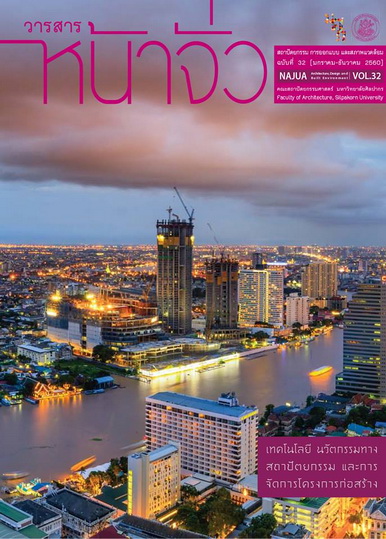วัสดุผนังอาคารทางพุทธศาสนาที่มีผลต่อการถ่ายเทความร้อน: ไม้ ผนังก่ออิฐฉาบปูน และผนังกรุแผ่นเงิน
Keywords:
การถ่ายเทความร้อน, วัสดุผนัง, อาคารทางพุทธศาสนา, Heat transfer, Wall materials, Religious buildingsAbstract
งานวิจัยชิ้นนี้มีวัตถุประสงค์เพื่อศึกษาค่าการถ่ายเทความร้อนของวัสดุผนัง เปรียบเทียบกับค่าอุณหภูมิผนังที่ทำการเก็บข้อมูลจริง โดยวัสดุที่จะทำการศึกษานั้นแบบออกเป็น 3 ประเภท คือ ผนังไม้ ผนังก่ออิฐฉาบปูน และผนังกรุแผ่นเงิน ของอาคารพุทธศาสนาที่นำมาเป็นกรณีศึกษา ได้แก่ วิหารวัดโลกโมฬี วิหารวัดพันเตา อุโบสถเงินวัดศรีสุพรรณ และวิหารวัดกู่คำ
วิธีการศึกษาเปรียบเทียบ ทำโดยการเก็บข้อมูลโดยการติดตั้งเครื่อง Data logger เพื่อเก็บข้อมูลผนังภายในของอาคาร ด้านทิศตะวันตกและทิศตะวันออก ซึ่งมีการตั้งค่าให้เก็บข้อมูลเป็นระยะเวลา 1 สัปดาห์ ทุก 20 นาทีต่อวัน ภายในเดือนมิถุนายน เนื่องจากเดือนนี้จะเกิดปรากฏการณ์กลางวันยาวที่สุดในรอบปี นั่นคือประเทศที่อยู่เหนือละติจูดที่ 66.5 องศาขึ้นไป จะมีช่วงกลางวันยาวนานตลอด 24 ชั่วโมง หรือที่เรียกว่า พระอาทิตย์เที่ยงคืน คือ พระอาทิตย์จะอยู่ต่ำสุดทางทิศเหนือ เมื่อเวลาเที่ยงคืน นอกจากนี้ยังได้ศึกษาข้อมูลของค่าการนำความร้อน (K-Value) ไปพร้อมกัน เพื่อนำไปสู่การหาค่าการถ่ายเทความร้อนของวัสดุ (U-Value) และค่าความต้านทานความร้อน (R-Value) หลังจากการวิเคราะห์ข้อมูลเรียบร้อยแล้วก็จะนำมาเปรียบเทียบเพื่อให้ทราบปัจจัยที่มีผลต่อการถ่ายเทความร้อนของอาคารทางพุทธศาสนา
ผลการศึกษาพบว่า ผนังที่ใช้วัสดุประเภทไม้ มีค่าสัมประสิทธิ์การถ่ายเทความร้อน (U-Value) ต่ำที่สุด คือ 1.078 W/m2-oC ซึ่งแสดงให้เห็นว่า มีการถ่ายเทความร้อนของวัสดุผนังได้ดี และมีค่าความต้านทานความร้อน (R-Value) สูง คือ 0.927 m2- oC/W แสดงว่ามีการต้านทานความร้อนได้ดีเช่นกัน รองลงมาคือ วัสดุประเภทก่ออิฐฉาบปูน และวัสดุประเภทกรุแผ่นเงินตามลำดับ เมื่อเปรียบเทียบค่าสัมประสิทธิ์การถ่ายเทความร้อนและค่าความต้านทานของวัสดุ กับอุณหภูมิที่ได้เก็บข้อมูลจากการใช้งานจริงของผนังอาคารทางพุทธศาสนาพบว่า ปัจจัยที่ส่งผลต่อการถ่ายเทความร้อนของวัสดุต่าง ๆ ที่ผ่านมวลสารของผนังอาคารอาจจะขึ้นอยู่กับปัจจัยดังต่อไปนี้ เช่น คุณสมบัติทางความร้อนของวัสดุที่เป็นผนังอาคาร การจัดวางตำแหน่งของอาคาร ทิศทางการหันของวัสดุผนังภายนอกอาคาร สีของวัสดุผนัง การระบายอากาศ และสภาวะอากาศภายนอก เป็นต้น รวมถึงบริบทโดยรอบอาคารนั้น ๆ อาจจะมีทั้งการบดบังของตัวอาคารเอง หรือ ศาสนสถานอื่น ๆ ต้นไม้ ซึ่งปัจจัยที่กล่าวมานี้ล้วนแต่ช่วยให้อาคารทางพุทธศาสนา มีการถ่ายเทความร้อนภายในอาคาร และสร้างสภาวะที่น่าสบายให้กับผู้ใช้งานได้ทั้งสิ้น
Wall materials of religious buildings and heat transfer : wooden, masonry, and silver-gilded sheet wall
Khanjana Patanompee
Faculty of Arts and Architecture, Rajamangala University of Technology Lanna
The Objectives of this research is to study the heat transfer coefficient of wall materials comparing with the actual wall temperature. Three types of materials- wood, Brick, silver sheets of the religious buildings were investigated in this case study. The temple of Wat Lok Molee, Wat
phantao, Ubosot of Wat Si Suphan and Temple of Wat Ku Kham were selected to be the models in this study.
The method of the comparative study for data collection has been done by installing a Data logger in order to record the data in the inner wall of the building on the west and east sides. The setting was set to collect the data for 1 week, in every 20 minutes per day in June. This month was reported as the longest daylight in the year. The countries located above the latitude of 66.5 degrees or higher are influenced, known as the midnight sun which is the lowest sun to the North. Along with the data collection, K-Value was determined for U-Value and R-Value comparison analysis and defined the factors that affect the heat transfer of religious buildings.
The study found that the wood-based wall has the lowest U-Value coefficient at 1.078 W/m2-oC, which shows the best heat transfer of wall material. It also has the high R-value, 0.927 m2-oC/W which indicates the good thermal resistance as well, followed by the materials such as masonry and silver sheets, respectively. When comparing heat transfer coefficients and material resistances with the temperature collected from the actual use from religious wall, it was found that various factors of the materials could affect the heat transfer through the mass of the building walls. Those factors could rely on the thermal properties of the materials, the position of the building, the direction of the facing, the wall materials, the ventilation, external weather, as well as the surrounding context of the building. The obscurations also might be another factor shading the building itself. As well as the buildings nearby and trees are helpful for the internal heat transfer in the buildings and create a comfortable environment for the all users.





